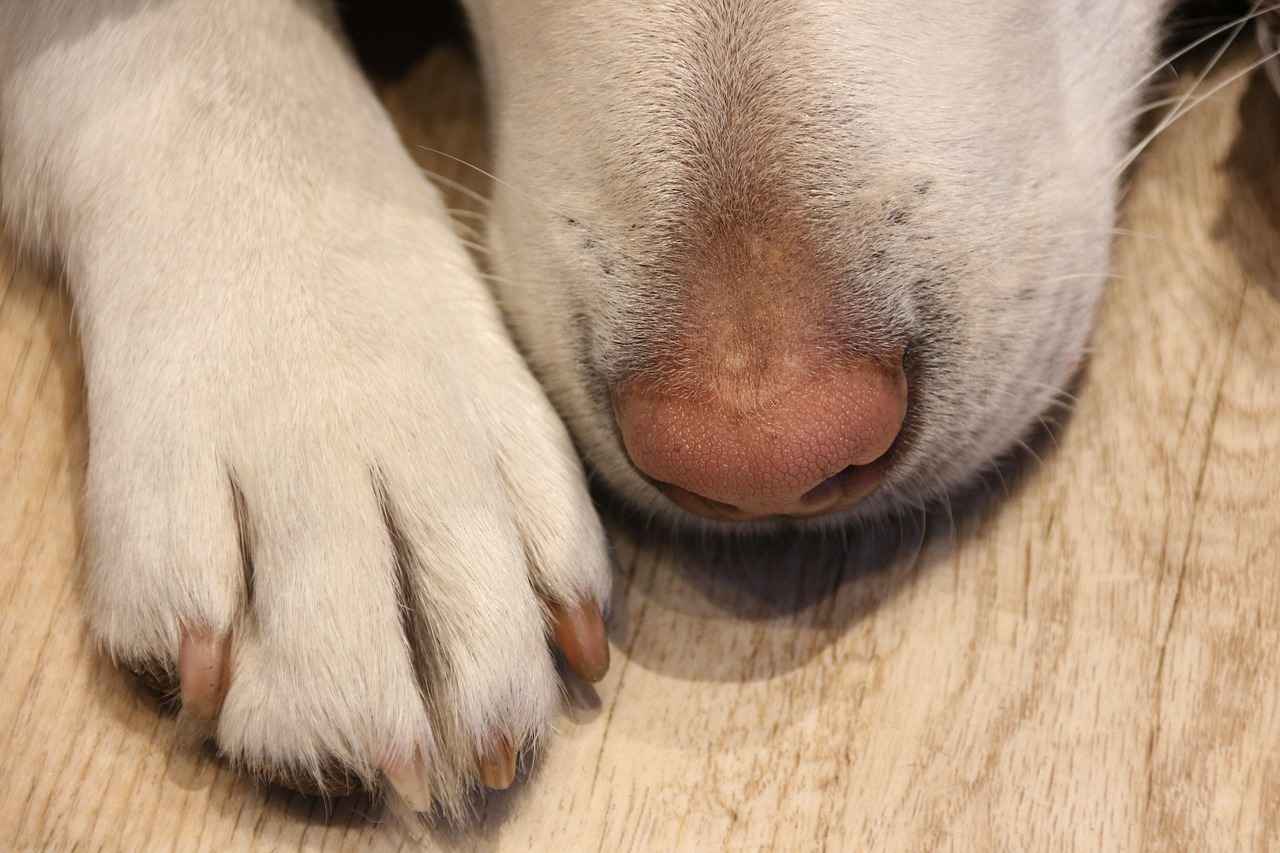This article delves into the various reasons why dogs may bite their paws, along with effective solutions to address this behavior. Understanding the causes can significantly enhance your pet’s well-being.
Understanding Canine Behavior
Dogs may exhibit paw-biting behavior for various reasons, including anxiety, boredom, or underlying medical conditions. Recognizing these behaviors is crucial for pet owners to effectively tackle the issue.
Common Causes of Paw Biting
- Allergies: Allergies to food, pollen, or dust mites can lead to itching and discomfort, prompting dogs to bite their paws.
- Parasites: Fleas and ticks can cause significant irritation, leading dogs to bite their paws in an attempt to relieve discomfort.
- Behavioral Issues: Anxiety and stress can manifest as paw biting, making it essential to understand the emotional triggers.
Identifying Allergy Symptoms
Common symptoms of allergies in dogs include excessive scratching, licking, and paw biting. Observing these signs can help owners determine if allergies are the cause of the behavior.
Treating Allergies in Dogs
Consulting a veterinarian for allergy testing and treatment options, such as antihistamines or dietary changes, is crucial for managing allergic reactions in dogs.
Behavioral Issues and Anxiety
Dogs suffering from separation anxiety may resort to paw biting as a coping mechanism when left alone. Identifying signs of anxiety can aid in developing a management plan.
Dealing with Stress and Boredom
Lack of mental and physical stimulation can lead to boredom, causing dogs to engage in destructive behaviors, including paw biting. Providing enrichment activities is key to preventing this behavior.
Veterinary Consultation: When to Seek Help
If paw biting persists despite attempts to address it, consulting a veterinarian is crucial. Professional guidance can help identify underlying medical or behavioral issues and provide tailored solutions.
Home Remedies for Paw Biting
There are several home remedies pet owners can try to alleviate paw biting, including soothing topical treatments and environmental adjustments. These can effectively complement veterinary care.
Preventing Paw Biting in the Future
Preventing paw biting involves a combination of regular health check-ups, proper grooming, and providing mental stimulation. Proactive measures can significantly reduce the likelihood of this behavior recurring.
Conclusion: Understanding and Addressing Paw Biting
Recognizing the reasons behind paw biting is essential for effective intervention. With proper understanding and management strategies, pet owners can help their dogs lead healthier, happier lives.

Understanding Canine Behavior
is essential for any dog owner. Dogs are not only our companions but also complex beings with unique emotional and physical needs. One common behavior that may puzzle pet owners is paw biting. This behavior can arise from a variety of factors, and understanding these can significantly improve a dog’s quality of life.
Dogs may bite their paws for several reasons, including:
- Anxiety: Just like humans, dogs can experience anxiety. Situations such as being left alone, loud noises, or changes in their environment may trigger stress, leading them to chew on their paws as a coping mechanism.
- Boredom: Dogs require mental stimulation and physical activity. Without sufficient exercise or engagement, they may resort to destructive behaviors, including paw biting.
- Medical Conditions: Various health issues such as allergies, skin infections, or parasites can cause itching and discomfort, prompting dogs to bite their paws in an attempt to relieve the irritation.
To effectively address paw biting, it is crucial for pet owners to identify the underlying cause. For instance, if allergies are suspected, observing for signs such as excessive licking or redness in the paws can help pinpoint the issue. In such cases, consulting a veterinarian is highly recommended as they can provide appropriate treatment options, including medications or dietary adjustments.
Additionally, providing a stimulating environment can help alleviate boredom-related paw biting. Engaging your dog in interactive play, regular walks, and mental challenges can significantly reduce stress and destructive behaviors.
In conclusion, understanding canine behavior is vital for dog owners. By recognizing the reasons behind paw biting and implementing effective strategies, pet owners can ensure their dogs lead healthier and happier lives.

Common Causes of Paw Biting
Paw biting in dogs can be a concerning behavior for pet owners, often indicating underlying issues that need to be addressed. Understanding the various causes is crucial in finding effective solutions for your furry friend. Here, we explore the most common reasons why dogs may engage in this behavior.
- Allergies: Allergies are one of the primary reasons dogs bite their paws. They can be triggered by a variety of substances including food ingredients, pollen, or dust mites. When dogs experience allergic reactions, they often feel itchy and uncomfortable, leading them to chew on their paws in an attempt to relieve the irritation.
- Parasites: Fleas, ticks, and mites can cause significant discomfort in dogs. These parasites irritate the skin, prompting dogs to bite their paws as a response to the itching. Regular parasite control is essential in preventing these issues.
- Behavioral Issues: Emotional factors such as anxiety, stress, and boredom can also lead to paw biting. Dogs that feel anxious or bored may resort to this behavior as a coping mechanism. Providing adequate mental stimulation and exercise can help alleviate these feelings.
- Injuries or Pain: Sometimes, paw biting can be a sign of pain or injury. If a dog has a cut, thorn, or other injury on their paw, they may lick or bite the affected area. Observing your dog’s behavior and consulting a veterinarian if pain is suspected is important.
- Dermatitis: Skin conditions such as dermatitis can cause extreme itchiness, leading dogs to bite their paws. Conditions like contact dermatitis may result from exposure to irritants or allergens in the environment.
Identifying the specific cause of paw biting is essential for effective treatment and prevention. If the behavior persists, it is advisable to consult a veterinarian for a thorough examination and tailored solutions.
Allergies: A Leading Cause
Allergies in Dogs: A Leading Cause of Paw Biting
Allergies are a significant concern for many dog owners, as they can lead to various uncomfortable symptoms for our furry friends. When dogs experience allergies, they often display signs of distress, such as itching, scratching, and, notably, biting their paws. Understanding the different types of allergies and their symptoms is crucial for effective management.
Types of Allergies Affecting Dogs
- Food Allergies: Certain ingredients in dog food can trigger allergic reactions, causing skin irritations and gastrointestinal issues.
- Environmental Allergies: Pollen, mold, and dust mites are common allergens that can affect dogs, especially during specific seasons.
- Flea Allergies: Even a single flea bite can lead to severe allergic reactions in sensitive dogs, resulting in intense itching and discomfort.
Recognizing Allergy Symptoms
Identifying the signs of allergies in dogs is essential for timely intervention. Common symptoms include:
- Excessive licking of paws
- Red or inflamed skin
- Frequent scratching
- Ear infections
- Vomiting or diarrhea (in cases of food allergies)
Seeking Veterinary Care
If you notice any of these symptoms in your dog, it is vital to consult a veterinarian. They can conduct tests to determine the specific allergens affecting your pet and recommend appropriate treatments, which may include:
- Antihistamines
- Specialized diets
- Topical treatments to relieve itching
Conclusion
Understanding the role of allergies in paw biting is crucial for any dog owner. By recognizing the symptoms and seeking veterinary care, you can help your dog find relief from discomfort and improve their overall quality of life.
Identifying Allergy Symptoms
Understanding the symptoms of allergies in dogs is crucial for pet owners. Recognizing these signs can lead to timely interventions and improved health for your furry friend. Common symptoms include:
- Excessive Scratching: Dogs may scratch their skin frequently, often leading to redness or irritation.
- Licking: Persistent licking of paws or other body parts can indicate discomfort caused by allergens.
- Paw Biting: This behavior often stems from itchiness and can result in further skin issues.
- Ear Infections: Allergies can lead to frequent ear infections, characterized by shaking of the head or scratching at the ears.
- Watery Eyes: Allergic reactions can cause excessive tearing, leading to watery eyes.
- Red or Inflamed Skin: Areas of the skin may appear red or inflamed, indicating an allergic reaction.
- Digestive Issues: Some dogs may experience vomiting or diarrhea as a result of food allergies.
It is essential for dog owners to monitor their pets for these symptoms. If you notice any of these signs, it may be an indication of an allergic reaction. Early identification can lead to effective treatment options, such as dietary changes or medication.
Consulting a veterinarian is crucial if you suspect your dog has allergies. They can perform tests to identify specific allergens and recommend appropriate treatments. This proactive approach can significantly improve your dog’s quality of life.
In conclusion, being vigilant about your dog’s health and recognizing the symptoms of allergies can help ensure they receive the care they need. Remember, a happy dog is a healthy dog!
Treating Allergies in Dogs
is a critical aspect of ensuring your furry friend remains healthy and comfortable. Allergies in dogs can manifest in various forms, often leading to discomfort and distress. It is essential for pet owners to recognize the signs and seek appropriate treatments to alleviate their pets’ suffering.
When a dog exhibits symptoms such as excessive scratching, licking, or biting at their paws, it may indicate an allergic reaction. Common allergens include food ingredients, pollen, dust mites, and even certain fabrics. Therefore, identifying the specific allergen is the first step toward effective treatment.
Consulting a veterinarian is crucial for allergy testing. A vet can perform skin or blood tests to determine what your dog is allergic to. Once the allergens are identified, the veterinarian can recommend a tailored treatment plan. This may include:
- Antihistamines: These can help reduce itching and inflammation.
- Corticosteroids: In more severe cases, these medications may be prescribed to control allergic reactions.
- Dietary Changes: Switching to a hypoallergenic diet can significantly help in managing food allergies.
- Immunotherapy: This long-term treatment gradually desensitizes your dog to specific allergens.
In addition to medical treatments, it’s important to create an environment that minimizes exposure to allergens. Regular cleaning of your home, frequent bathing of your dog with hypoallergenic shampoos, and ensuring a dust-free living space can greatly improve your dog’s quality of life.
In conclusion, addressing allergies in dogs requires a comprehensive approach that includes veterinary consultation, proper medication, and environmental management. By understanding the causes and treatments, pet owners can help their dogs lead happier, healthier lives.
Parasites: Fleas and Ticks
Fleas and ticks are common parasites that can significantly impact a dog’s health and comfort. These pests not only cause itching and irritation but can also lead to more serious health issues if left untreated. Understanding the effects of these parasites and implementing effective prevention strategies is crucial for every dog owner.
When fleas or ticks infest a dog, the animal often experiences intense discomfort. This can lead to behaviors such as biting or licking their paws in an attempt to relieve the irritation caused by these parasites. The biting can create a vicious cycle, as it may lead to secondary infections or hot spots on the skin, exacerbating the problem.
Regular parasite control is essential for prevention. This includes routine checks for fleas and ticks, especially after outdoor activities. Using veterinarian-recommended products, such as topical treatments, oral medications, and flea collars, can help keep these pests at bay. Additionally, maintaining a clean environment by washing pet bedding and vacuuming regularly can reduce the risk of infestations.
It is important to note that fleas and ticks can transmit various diseases to dogs, including Lyme disease and tapeworms. Therefore, if you notice your dog biting their paws frequently, it is crucial to inspect them for signs of these parasites. Early detection and treatment can prevent more severe health issues down the line.
In conclusion, being proactive about parasite control is vital for your dog’s health and well-being. Regular veterinary check-ups, combined with effective prevention strategies, can ensure your furry friend remains comfortable and free from the discomfort caused by fleas and ticks.

Behavioral Issues and Anxiety
can significantly affect a dog’s overall well-being. One common manifestation of these emotional challenges is paw biting. This behavior often raises concerns among pet owners, as it may indicate underlying issues that require attention.
Dogs, much like humans, experience a range of emotions. Factors such as stress, anxiety, and even boredom can lead to compulsive behaviors, including paw biting. Understanding these emotional triggers is crucial for owners aiming to address and manage their pets’ behaviors effectively.
| Common Emotional Triggers | Behavioral Manifestation |
|---|---|
| Separation Anxiety | Paw biting when left alone |
| Stress | Increased licking or chewing of paws |
| Boredom | Destructive behaviors, including paw biting |
Separation anxiety is particularly prevalent in dogs that form strong attachments to their owners. When left alone for extended periods, these dogs may resort to paw biting as a coping mechanism. Identifying signs of anxiety, such as excessive barking or destructive behavior, can help owners develop effective management plans.
Additionally, stress from environmental changes, such as moving homes or the introduction of new pets, can lead to paw biting. Providing a stable environment and routine can help alleviate some of this stress.
Moreover, a lack of physical and mental stimulation can result in boredom, prompting dogs to engage in self-soothing behaviors like paw biting. Owners can combat this by incorporating regular exercise and interactive play into their dog’s daily routine.
Ultimately, understanding the emotional landscape of your dog is key to addressing behavioral issues like paw biting. By recognizing the triggers and implementing strategies to mitigate stress and boredom, owners can foster a healthier, more balanced emotional state for their pets.
Separation Anxiety
is a common issue that affects many dogs, leading to various behavioral problems, including paw biting. This behavior can be distressing for both the dog and the owner. Understanding the signs and developing a management plan is crucial for helping your furry friend cope with this condition.
When dogs experience separation anxiety, they often feel intense distress when left alone. This can result in behaviors such as excessive barking, destructive chewing, and, notably, paw biting. Paw biting serves as a coping mechanism, allowing the dog to relieve some of the anxiety they feel when their owner is not present.
Recognizing the signs of separation anxiety is the first step in addressing the issue. Common indicators include:
- Destructive Behavior: Chewing furniture or personal items.
- Excessive Barking or Whining: Vocalizations that occur only when the owner is away.
- Paw Biting: Repeatedly biting or licking their paws, often leading to irritation or injury.
- House Soiling: Accidents in the house despite being house-trained.
To effectively manage separation anxiety, consider these strategies:
- Gradual Desensitization: Slowly acclimate your dog to being alone for short periods, gradually increasing the duration.
- Positive Reinforcement: Reward calm behavior when leaving and returning home.
- Interactive Toys: Provide engaging toys that can keep your dog occupied while you are away.
- Consult a Professional: If the anxiety is severe, a veterinarian or a certified dog trainer can offer tailored solutions.
In conclusion, understanding and addressing in dogs is vital for their well-being. By recognizing the signs and implementing effective management strategies, owners can help their pets feel more secure and reduce behaviors like paw biting.
Dealing with Stress and Boredom
Dogs, like humans, require both mental and physical stimulation to thrive. When they lack these essential activities, they can become bored, which may lead to various destructive behaviors, including the troubling habit of paw biting. Understanding the significance of enrichment activities is crucial for preventing this behavior and ensuring your dog’s overall well-being.
One of the primary reasons dogs engage in paw biting is due to boredom. Without sufficient engagement, dogs may resort to chewing on their paws as a way to relieve their frustration and pent-up energy. This behavior can become a vicious cycle, as the more they bite their paws, the more distressed they may become, leading to increased anxiety and further destructive behaviors.
To combat boredom, it’s essential to provide a variety of enrichment activities that stimulate your dog’s mind and body. Here are some effective strategies:
- Interactive Toys: Invest in puzzle toys that challenge your dog to think and solve problems. These toys can keep your pet occupied for hours.
- Regular Exercise: Ensure your dog receives daily walks, playtime, and opportunities to run. Physical activity is vital for reducing stress and boredom.
- Training Sessions: Engage your dog in training sessions that teach new tricks or reinforce basic commands. This not only stimulates their mind but also strengthens your bond.
- Socialization: Arrange playdates with other dogs or take your pet to dog parks. Social interactions can alleviate feelings of loneliness and boredom.
- Variety in Routine: Change up your dog’s routine by introducing new routes for walks or different activities. This keeps their environment fresh and exciting.
In conclusion, providing adequate mental and physical stimulation is key to preventing destructive behaviors like paw biting. By incorporating enriching activities into your dog’s daily routine, you can help them stay happy, healthy, and engaged. This proactive approach not only enhances their quality of life but also fosters a deeper bond between you and your furry friend.

Veterinary Consultation: When to Seek Help
When your dog exhibits persistent paw biting, it is essential to recognize that this behavior may indicate underlying issues that require professional attention. While many pet owners attempt to address the problem through home remedies or behavioral modifications, these methods may not always be sufficient. Consulting a veterinarian is a critical step in identifying the root causes and implementing effective solutions.
Veterinarians are trained to evaluate both medical and behavioral aspects of canine health. They can perform comprehensive examinations to rule out physical ailments such as:
- Allergies: Food or environmental allergies can lead to severe itching and discomfort.
- Parasites: Fleas, ticks, or mites can irritate the skin, causing dogs to bite their paws.
- Infections: Bacterial or fungal infections may also result in paw irritation.
In addition to medical evaluations, veterinarians can assess behavioral issues like anxiety or stress that might contribute to paw biting. They may suggest behavioral therapies or refer you to a canine behaviorist for further assistance.
It’s important to note that early intervention can prevent more serious problems from developing. If your dog’s paw biting persists despite your efforts, don’t hesitate to seek professional help. A veterinarian can provide tailored solutions, including:
- Medications to alleviate itching and inflammation.
- Behavioral modification plans.
- Advice on environmental changes to reduce stress.
In conclusion, while it may be tempting to manage paw biting at home, seeking a veterinary consultation is vital for your dog’s health and well-being. By addressing the issue with professional guidance, you can ensure that your furry friend receives the care they need to lead a happy and healthy life.

Home Remedies for Paw Biting
Paw biting in dogs can be a distressing behavior for both pets and their owners. Fortunately, there are several home remedies that can help alleviate this issue. These remedies can serve as effective complements to veterinary care, ensuring your dog finds relief and comfort.
- Soothing Topical Treatments: Applying natural remedies such as coconut oil or aloe vera gel can help soothe irritated skin on your dog’s paws. These substances have anti-inflammatory properties that can reduce itching and promote healing.
- Oatmeal Baths: Giving your dog an oatmeal bath can provide relief from itching and inflammation. Oatmeal is known for its soothing properties and can help calm your dog’s skin.
- Environmental Adjustments: Assessing your dog’s environment is crucial. Removing allergens such as dust, pollen, or certain cleaning products can greatly reduce irritation. Consider using air purifiers or hypoallergenic cleaning supplies.
- Providing Distractions: Engaging your dog in regular exercise and mental stimulation can help reduce boredom-related paw biting. Interactive toys, puzzle feeders, and regular walks can keep your dog occupied.
- Dietary Changes: Sometimes, paw biting can be linked to food allergies. Consulting with your veterinarian about a hypoallergenic diet may help identify and eliminate potential allergens.
Implementing these home remedies can significantly improve your dog’s condition. However, if the behavior persists, it is essential to consult with a veterinarian to rule out underlying medical issues. By taking proactive steps and observing your dog’s behavior closely, you can help them lead a more comfortable and happy life.

Preventing Paw Biting in the Future
To effectively prevent paw biting, it is essential to adopt a holistic approach that includes regular health check-ups, proper grooming, and ensuring your dog receives adequate mental stimulation. By implementing these proactive measures, pet owners can significantly reduce the chances of this behavior recurring.
First and foremost, regular health check-ups are vital. Routine veterinary visits allow for early detection of any underlying health issues, such as allergies or parasites, that may contribute to paw biting. During these visits, your veterinarian can provide guidance on appropriate vaccinations and preventive treatments that can enhance your dog’s overall health.
Proper grooming is another critical component. Regularly grooming your dog not only keeps their coat clean but also allows you to inspect their paws for any signs of irritation, cuts, or foreign objects that could cause discomfort. Trimming nails and cleaning between the paw pads can help prevent painful conditions that may lead to biting.
In addition, providing mental stimulation is essential in preventing boredom-related behaviors, including paw biting. Engaging your dog in interactive play, puzzle toys, and training exercises can keep their minds active and reduce the urge to chew on their paws. Regular walks and socialization with other dogs can also contribute to a well-rounded and happy pet.
Lastly, creating a calm environment can help alleviate anxiety-related paw biting. Consider using calming aids, such as pheromone diffusers or anxiety wraps, to help your dog feel more secure. Establishing a consistent routine can also provide comfort and stability.
By taking these steps, pet owners can create a healthier, happier environment for their dogs, ultimately minimizing the risk of paw biting and enhancing their overall well-being.

Conclusion: Understanding and Addressing Paw Biting
Recognizing the reasons behind paw biting is essential for effective intervention. This behavior can stem from a variety of factors, including allergies, parasites, and behavioral issues. Understanding these underlying causes is crucial for pet owners who wish to help their dogs lead healthier, happier lives.
Many dogs may bite their paws due to discomfort caused by allergies to food or environmental factors. Symptoms such as excessive licking, scratching, and biting should not be overlooked. If you notice these signs, it is important to consult with a veterinarian for appropriate testing and treatment options, which may include antihistamines or dietary adjustments.
Additionally, parasites like fleas and ticks can cause significant irritation, leading to paw biting as a means of relief. Regular parasite control is essential for prevention. Ensuring your dog’s environment is free from these pests can greatly reduce the likelihood of this behavior.
Moreover, behavioral issues such as anxiety or boredom can also lead to paw biting. Dogs suffering from separation anxiety may resort to this behavior when left alone. Identifying the emotional triggers and providing mental stimulation through toys, exercise, and companionship can help mitigate these issues.
In cases where paw biting persists despite these interventions, seeking professional help from a veterinarian or a certified animal behaviorist is crucial. They can provide tailored solutions that address both medical and behavioral concerns.
In conclusion, understanding and addressing the reasons behind paw biting involves a comprehensive approach that includes recognizing symptoms, consulting professionals, and implementing preventive measures. By taking these steps, pet owners can significantly improve their dogs’ quality of life.
Frequently Asked Questions
- Why does my dog bite its paws?
Dogs may bite their paws for various reasons, including allergies, parasites, anxiety, or boredom. It’s essential to observe their behavior closely to determine the underlying cause.
- What are the signs of allergies in dogs?
Common signs of allergies include excessive scratching, licking, and biting of the paws. You might also notice redness or swelling on their skin.
- How can I treat my dog’s paw biting?
Treatment depends on the cause. For allergies, consult a veterinarian for appropriate medication or dietary changes. If it’s behavioral, consider providing more mental stimulation and exercise.
- When should I see a veterinarian?
If your dog’s paw biting persists despite home remedies, or if you notice severe symptoms like bleeding or infection, it’s time to consult a vet for professional advice.
- Are there home remedies for paw biting?
Yes! Some effective home remedies include soothing topical treatments and ensuring your dog has a stimulating environment to reduce boredom and stress.












